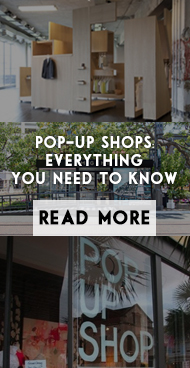First there were pop-up books for children. Then there were pop-up ads online, which annoyed a lot of people. Now there are pop-up shops, and they’re growing in popularity.
What is a pop-up shop? Also known as pop-up or flash retail, a pop-up shop is a short-term, temporary retail store. The first sightings go back to the ‘90s. Pop-up shops come in many shapes and sizes: They can be set up via rental of a physical store, an indoor or outdoor kiosk, or in a vehicle like a food truck. Around this time of year, you see plenty of Halloween stores that fit this description.
Perhaps one of the most unique pop-up — one that is going viral online — is one affixed 6,000 feet above ground to the side of a cliff. The shop, open only 24 hours, was part of a marketing effort to raise funds for the Access Fund and American Alpine Club.
While most retail owners pride themselves on their store’s longevity, some pop-up shops go for the novelty factor. Stockholm denim label Cheap Monday opened a pop-store for just 10 minutes. There’s what claims to be the smallest pop-up shop — which actually combines the concept of a pop-up book and pop-up shop — for the Ford Fiesta. Recipients who received the mailer were instructed to place their smartphone into the “shop” to go on a virtual test drive. And, in what bills itself as the smallest pop-up shop with the largest inventory, Netshoes opened an online store disguised as a pop-up shop in São Paulo. The shop, about the width of an iPad, even has a door mat and miniscule signage. In the UK, Bunyadi opened a naked pop-up restaurant. How’s that for novelty?
Pop-up shops enable owners to connect with a wide variety of customers they would not have otherwise reached. They are affordable; owners aren’t faced with the high rental associated with a traditional retail store.
Today, pop-up shops have come a long way from the neighborhood kids’ lemonade stand and the stalls at local farmers’ and flea markets. According to industry statistics, they make about $50 billion in sales each year.
So how can you get on the pop-up bandwagon? As with any business, you still need a plan. Start with the basics:
- Set a goal
- Do your research (including competitors)
- Set a budget (include rental/utilities, WiFi, equipment, inventory, staffing, marketing)
- Pick a location
- Decide on your store’s look/layout
- Determine prices for your products
- Build brand awareness
Pop-up stores also can serve as a real-time testing site. Because you don’t need the amount of inventory required for a traditional store, you can change up your products more often based on supply and demand. Poll your customers to obtain demographics, preferences and other information. Be sure to have an in-store signup and capture email addresses for marketing efforts.
How do you determine if your pop-up shop is a success? Again, the metrics are similar to those of online and traditional brick-and-mortar stores:
- Track your (foot) traffic
- Analyze sales data
- Ask for customer feedback
- Monitor social media “buzz”
A great way to announce your pop-up to the world is to hold a launch party or a “soft” opening. Invite family, friends, the local community and the media. Everyone loves a party, and you’ll love the opportunity to showcase your shop.




